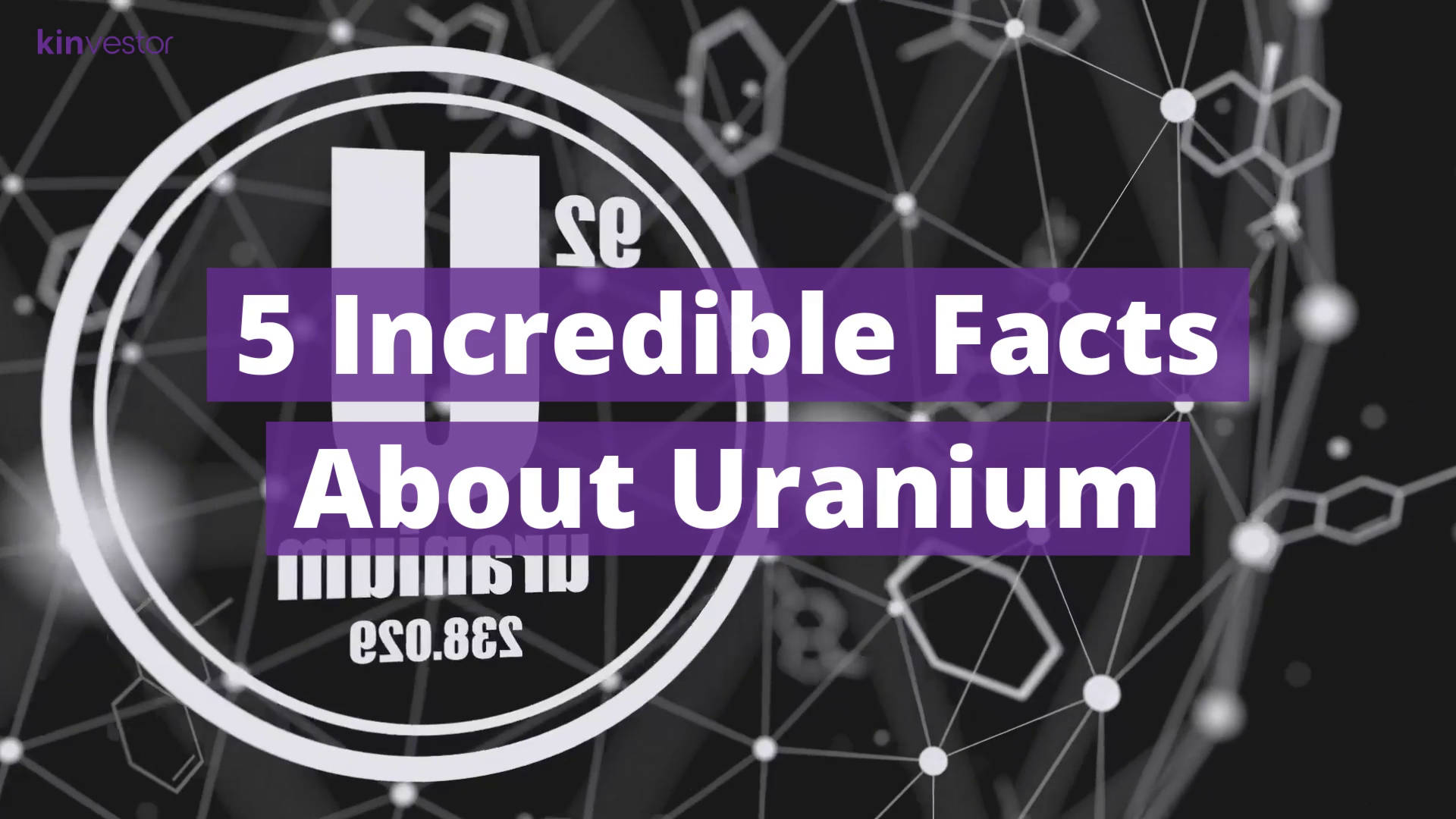
February 28, 2022
Uranium and the nuclear power it produces have been the subject of much controversy since the creation of the atomic bomb in 1945. Since then, uranium has increased in popularity as a safe, efficient alternative to traditional energy sources. Today, uranium-based nuclear power generates about 10% of the world’s electricity.
Keep reading for 5 incredible facts about this controversial commodity from the Kinvestor Network.

1. Otherworldly Origins
The earliest theory of how Earth’s uranium supply came to be suggested that the element was formed in one or more supernovae. A supernova explosion, explains the Oxford Dictionary of Physics, “occurs when a star has burned up all its available nuclear fuel and the core collapses catastrophically.” Since then, cosmochemists, scientists who study the chemical composition of matter in the universe, have proposed a second theory: that the uranium found in the Earth today is the result of a merger between neutron stars. According to this theory, the gravitational forces of these extremely dense bodies cause them to merge, creating gravitational waves and producing mass amounts of not only uranium, but gold and platinum as well.
Based on this information and the age of the Earth (around 4.5 billion years), scientists estimate that the events that produced the abundances of uranium found on Earth would have occurred anywhere from over 6 billion to about 200 million years ago from at least ten separate “stellar sources.”

2. Heating the Core
Uranium is the provider of the main heat source within the core of our planet. This is the result of a slow radioactive decay, which is part of uranium’s natural life cycle. The radioactive decay contributes around 20 terawatts of the Earth’s 30-to-44 terawatts of heat. For reference, global energy consumption in 2019 was around 23,000 terawatt-hours.
As they decay, uranium and other radioactive materials release neutrinos and antineutrinos, neutral particles that emit energy. The resulting heat and radiation contribute to continental drift, or the movement of the earth that results in the shifting of continents over the millennia. When the Earth was formed, scientists theorize, heat produced by uranium-235 and potassium-40 would have exceeded the heat produced by uranium-238. Today, most of the Earth’s energy is generated from the decay of U-238, which has a much longer half-life than U-235.

3. Natural Reaction
In 1956, Japanese-American chemist Dr. Paul Kuroda wrote a paper theorizing that natural nuclear reactors could have formed on the ancient Earth under certain conditions. According to Dr. Kuroda’s work, there are four main conditions needed for stable, naturally-occurring nuclear reactors to develop:
- First, the natural uranium must have a high enough uranium content and thickness.
- Second, the uranium deposit must have a significant amount of uranium-235, which is highly fissionable.
- Third, there must be a moderator, such as water, to slow down the neutrons produced by the fissioning uranium.
- Fourth, neutron-absorbing elements like silver or boron must not be present near the uranium or else they would impede the development of self-sustaining nuclear reactions.
In 1972, Dr. Kuroda’s theory was proven correct when French mining operations discovered “missing” U-235 in a uranium deposit in Gabon, West Africa. The “missing” U-235 provided scientists with a clue that some of the U-235 had already been used up in the natural reactor millions of years prior. Since then, sixteen other natural nuclear reactors have been discovered in Gabon. Scientists believe that in total, over their 2 million year lifetimes they produced approximately 5.4 tonnes of fission products and 1.5 tonnes of plutonium products.
To date, no other natural nuclear reactors have been discovered. Sixteen of the reactors were mined, leaving scientists with little to study, and the last has been preserved for study.

4. It Keeps Going
As we have already seen, uranium has been around since the formation of the Earth and doesn’t appear to be going anywhere any time soon. All isotopes of uranium are unstable, radioactive, and stick around for a long time. The decay of uranium is among the slowest of all radioactive materials – the half-life of the “fertile” uranium-238 is 4.5 billion years, around the same time as the age of the Earth, while the more fissile uranium-235 has a half life of around 700 million years.
Uranium-235 makes up about 0.70% of today’s natural uranium deposits, although when the Earth was formed it would have been as abundant as U-238, which today makes up 99.3% of natural uranium.
While U-238 is not as fissile as the less-common U-235, it is fertile, meaning that it “captures” neutrons flying around in the core of nuclear reactors, eventually turning into plutonium-239, which is fissile. According to the World Nuclear Association, about one third of nuclear energy comes from plutonium-239.
Once uranium has been in a nuclear reactor for about three years, it is considered “used” and is removed and either reprocessed or disposed of underground until the product is no longer considered radioactive.
According to the World Nuclear Association, “Used fuel still contains about 96% of its original uranium.” Several countries, including Russia, China, Japan, Belgium, France, Germany, Switzerland, and more, have policies in place to reprocess nuclear waste. Reprocessing the used nuclear material allows a significant amount of plutonium to be recovered and subsequently mixed with uranium oxide to create mixed oxide (MOX) fuel.

5. Safer Than You Think
As an energy source, uranium and nuclear power is considered low-carbon, safe, and efficient. Because it is so dense, with one pellet of uranium equal to 17,000 cubic feet of natural gas, 120 gallons of oil, and 1 tonne of coal, uranium produces much less waste than these other energy sources. Not only more efficient than traditional sources of energy, nuclear reactors have a much smaller footprint than other clean energy sources like solar and wind farms. The U.S. Department of Energy points out that “wind farms require 360 times more land area to produce the same amount of electricity and solar photovoltaic plants require 75 more space.” At that rate, a single commercial nuclear reactor produces as much power as 3 million solar panels or over 430 wind turbines.
In a paper from NASA’s Goddard Institute from 2013, former NASA scientist James Hansen and Pushker Kharecha at the Goddard Institute estimated that power generated by nuclear energy has “prevented 64 gigatonnes of carbon-dioxide-equivalent greenhouse-gas emissions, which would have accompanied the burning of fossil fuels, from entering the atmosphere.” Nuclear energy is also safer than other forms of energy production. Hansen and Kharecha also estimated that the use of nuclear power has prevented nearly 2 million deaths that would have occurred had that power been generated by burning fossil fuels.
As the need for clean energy becomes increasingly recognized by nations around the world, global leaders have created the Nuclear Innovation: Clean Energy Future (NICE) initiative, a global initiative that aims to bring nuclear energy into the clean energy conversation. Led by the United States, Canada, and Japan, the initiative is also supported by countries like Argentina, Brazil, France, Jordan, Kenya, Poland, Romania, Russia, the United Arab Emirates, and the United Kingdom.
For a video summary of these 5 Incredible Facts About Uranium, click here.
About the Kinvestor Network
The Kinvestor Network is an exclusive network of investors that want access to enhanced research and reporting. Members of the Kinvestor Network have access to exclusive articles, reports, models and various other tools that investors may find useful.
Visit the Kinvestor Network for more free content, including in-depth research reports, industry documentaries, CEO interviews, and more.
Please read this disclaimer in its entirety before reviewing any opinions, views or information expressed by Kin Communications Inc. (“Kin”).
Sources
World Nuclear Association: The Cosmic Origins of Uranium
Scientific American: Nuclear Fission Confirmed as Source of More than Half of Earth’s Heat
Statistica: Global electricity consumption 1980-2019
Radioactivity: Uranium 238 and 235
World Nuclear Association: What is Uranium? How Does it Work?
World Nuclear Association: Radioactive Waste Management
Office of Nuclear Energy: 3 Reasons Why Nuclear is Clean and Sustainable

